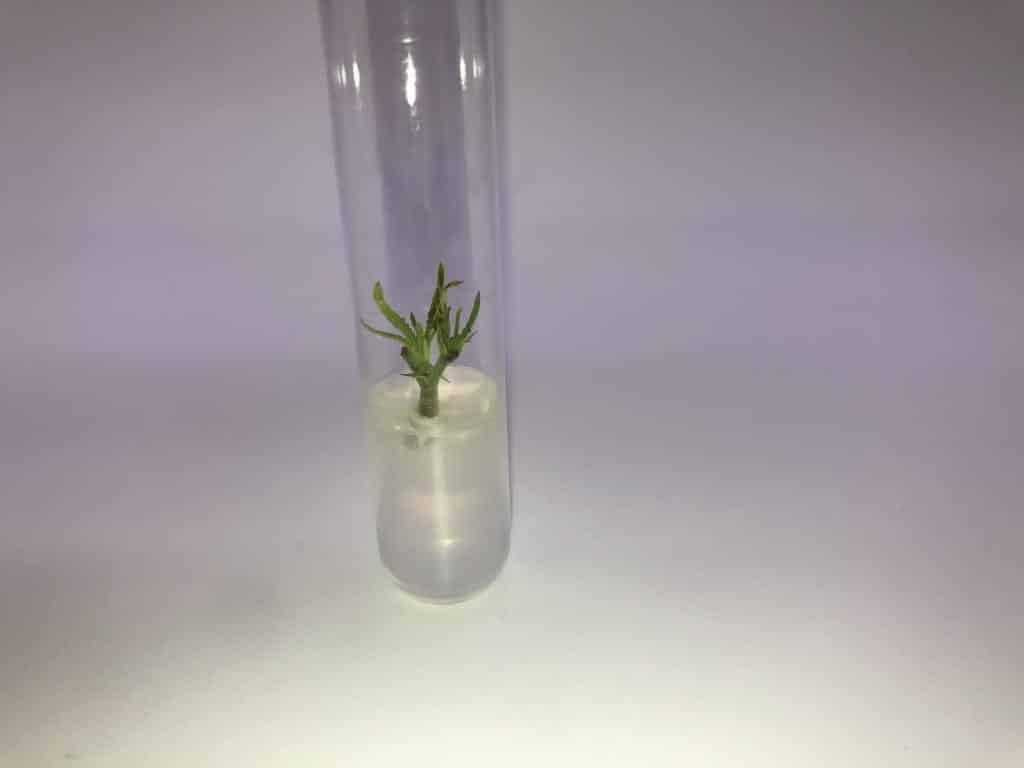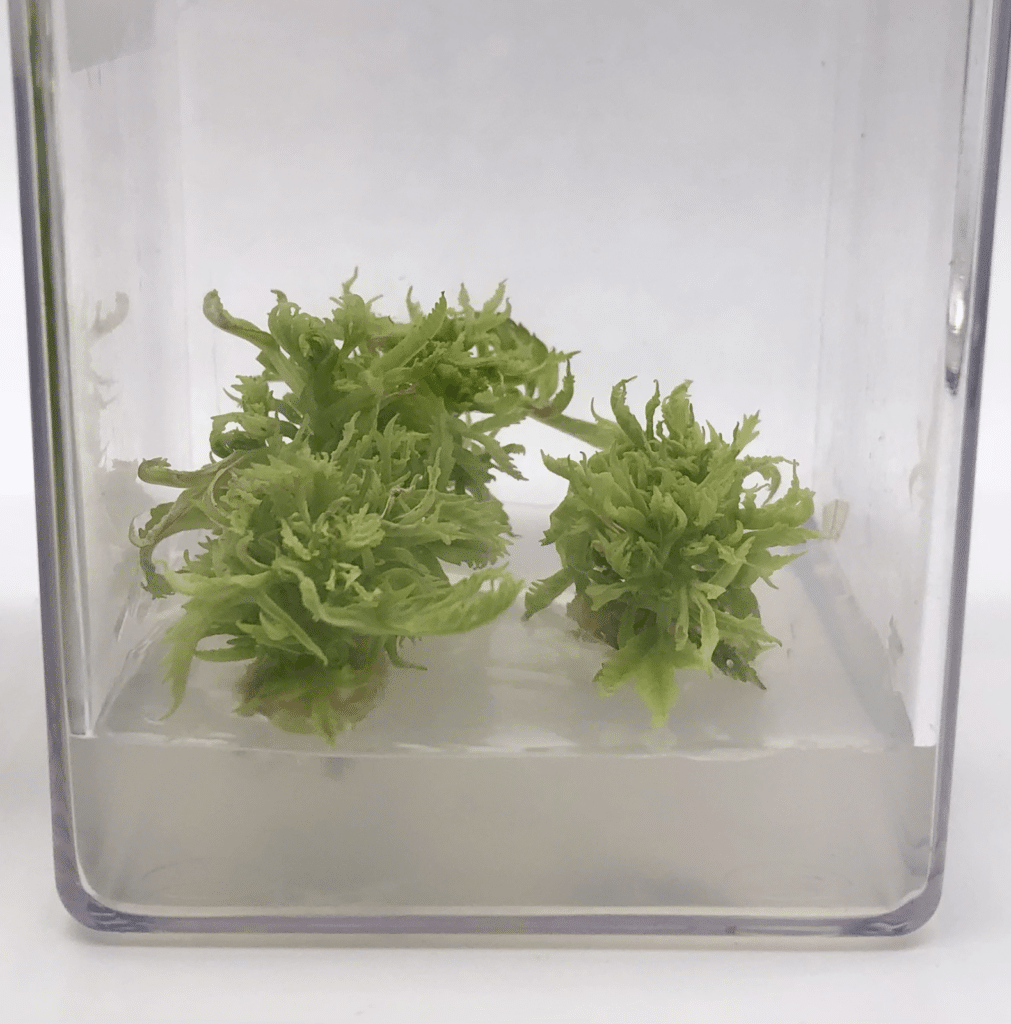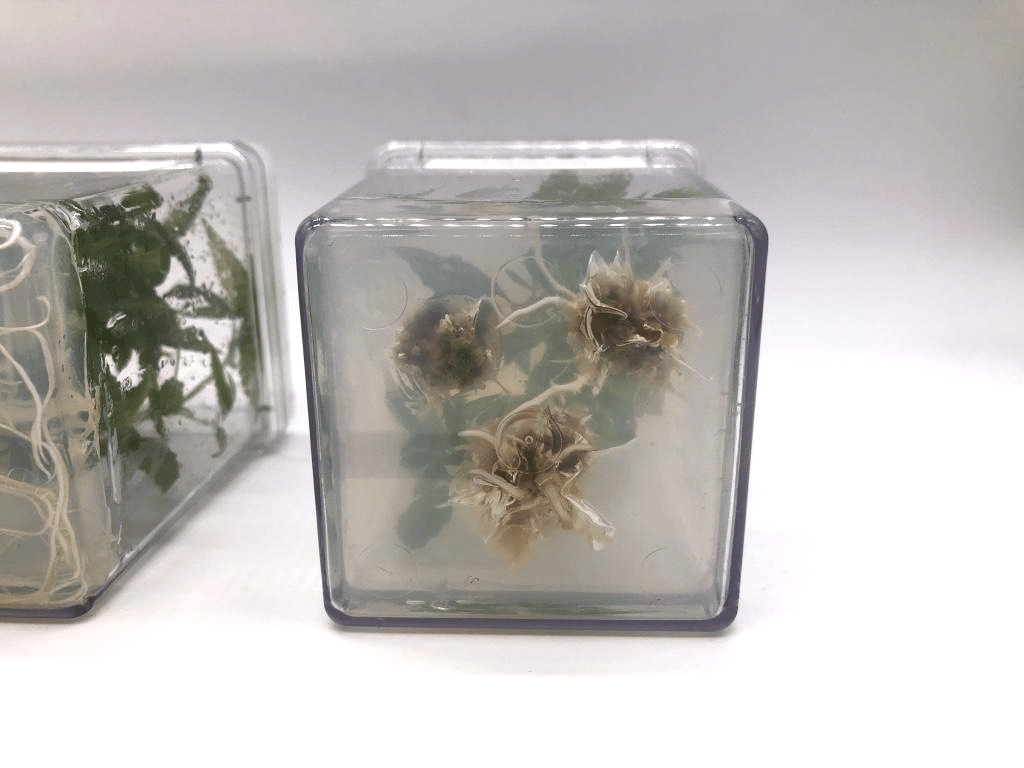Plant tissue culture (PTC) is a valuable tool used to maintain clean mother stock, conserve rare and endangered species, propagate difficult-to-root varieties, aid in genetic improvement, and much more. The broad and sometimes complex nature of the field can be confusing for curious cultivators, making it difficult to find a ‘starting’ point for those wanting to learn more about the subject.
Few have spent years inside a laminar flow hood and trained under top scientists to deeply understand the art and science of PTC, therefore it is important to equip growers and breeders with valuable information to consider, common misconceptions, and questions to ask a potential tissue culture lab partner.
A prominent misconception is that plants from culture are always clean. Although a cultured plant may still be cleaner than traditional vegetative propagation, it is still possible to spread virulent pathogens. A properly run lab will have protocols to monitor and limit the spread of pathogenic microbes in vitro.
One of the most important of these procedures is pathogen screening throughout the tissue culture process. This means testing for prominent pathogens before initiation to culture, routine testing of established tissue culture stock, and testing during acclimation and before shipping plants. It is not practical to test for every pathogen that can infect a species, but it is important to test for a handful of the most commonly known and economically impactful pathogens.

It is recommended that pathogens such as viruses and viroids are the primary focus when testing. These are the most elusive microorganisms due to their ability to hide deep within tissues without expressing symptoms. A handful of the most common that are documented at this time are Hop Latent Viroid, Lettuce Chlorosis Virus, Beet Curly Top Virus, Alfalfa Mosaic Virus, and Cannabis Cryptic Virus.
It is important to consider that only identified pathogens can be screened for and researchers will continue to discover new species of pathogens which should influence a lab’s selection of starting explant material.
Dissecting shoot apical meristems is recommended to achieve the cleanest plant material possible. It is important to note that a properly dissected meristem under a microscope will be smaller than a grain of sand and barely visible to the naked eye following initiation.
Meristems are located at the tip of every shoot and is where cells are actively dividing to generate new tissues. These bundles of cells are only a few millimeters wide and not yet connected to the plant’s vascular tissue, so theoretically pathogens cannot translocate to the meristem.
The concept was first developed in the early 1950s by George Morel and Claude Martin to remediate Dahlias from production inhibiting pathogens. The procedure has been used by the horticulture industry for clean stock and international government programs to preserve food security ever since.
It is important to inquire into the experience of the lab and scientists being considered as remediation attempts by even the most experienced tissue culturists are not a guaranteed success.

This process is tedious and requires an immense amount of testing over a long period of time to generate confidence that a viral pathogen is completely removed from the plant tissues. Caution is recommended if a PTC lab claims to guarantee remediation as the likelihood of success is low and it is a significant liability to regularly intake infected plants into the operation.
If you have the opportunity to visit a lab in person, there are a handful of observations to make and practices to inquire about to better understand the quality of the lab and its cultures. Bacteria and fungi are readily observed in vitro because they are attracted to the carbohydrates in the media which provides nutrition necessary to proliferate and reproduce.
Microbes have a faster rate of reproduction than plants which results in them overtaking the medium. These contaminated cultures should be scouted daily so they can be immediately autoclaved and disposed of as any microbes, either pathogenic or beneficial, can be detrimental to the growth of the plant and eventually lead to necrosis.
This is especially important during the acclimation stage where it can significantly impact explant survival in the greenhouse. Routine visual inspections of all cultures before opening, including holding vessels against a bright light to look for discoloration in the media or bacterial oozing from the cut end of the explant, is a minimal requirement for any tissue culture lab.
Another recommendation is to ask a lab if they are utilizing sterility test media to expose any endophytic microbes lurking in the tissues as not all microorganisms express themselves on plant-specific nutrient media. This special medium is either a nutrient broth or agar that microbes thrive on. It is used shortly after plants are initiated to culture to provide additional confidence that the plant material is clean before entering the multiplication stage.
Once plant material has been screened and successfully initiated, culture sterility is maintained through proper technician aseptic technique. Aseptic technique describes all routine procedures carried out to prevent culture contamination including, but not limited to personal hygiene, workstation disinfection, proper hand movement in the laminar flow hood, and routine tool sterilization.
Antibiotics and plant preservative mixture (PPM) can be added to media to reduce media contamination; however, this practice is not recommended as it results in resistant strains of microbes which become extremely challenging to manage.

Additionally, its usage leads to careless aseptic technique by technicians in the flow hood. Because sterility is foundational to any PTC lab, one that uses multiple screening techniques throughout their operation provides the highest confidence in the lab’s quality and cleanliness.
Another common misconception is that PTC guarantees consistent clones. In the lab, undiagnosable inconsistencies found between clonal regenerants are referred to as “somaclonal variations” and can be prominent depending on the species and cultivated variety (cultivar) in culture.
This essentially means that cuttings from the same donor plant do not perform similarly as they theoretically should and is likely due to where the cuts are taken from. Somatic mutations can also occur during the process and it is most prevalent when a lab is using high concentrations of plant growth regulators (PGRs) or antibiotics over prolonged periods.
Similar to animals, over exposure to these inputs can have mutagenic effects that negatively impact plant health. It is important to ask a lab about their hormone and antibiotic usage, but you can also identify overuse of PGRs when explants visually produce significant callus at the base of the cutting, and shoots appear chlorotic and deformed. Successful tissue culture requires careful selection of the right plant material, the appropriate growth medium, and meticulous lab conditions.
Germplasm storage is another valuable and important aspect of PTC. This service offers multiple benefits including preserving prized genetics, reducing labor, and strategizing menu offerings to better align with market projections or customer production schedules.
Safely preserving genetics is vital for plant breeders and when visiting a tissue culture provider it is important to inquire about the conditions under which genetics are stored. The most common practice is storage of established in vitro plants in refrigerators.
As the purpose of cold storage is to maintain stasis and reduce plant growth, it is important to inquire about the media your genetics will be stored in. Ideally, the lab of interest will have invested time into developing a specific storage media.
While plants will survive on production media in cold storage, your genetics will require more frequent subcultures, thereby increasing the cost of their maintenance and likelihood of mutations over time.
Synthetic seed is another technique utilized by traditional tissue culture operations. The procedure involves encapsulating a plant propagule into a sphere of media which is reminiscent of a seed. These synthetic seeds are then stored under refrigerated conditions.
This technique’s advantage lies in volume. Many more propagules can be stored in a single refrigerator than the more common method of storing established cultures. While this method is advantageous for the PTC lab by maximizing the amount of storage space, it often does not provide any additional benefits to the breeder seeking cold storage services.
The drawback to this technique is the extra labor of encapsulation in addition to the routine subcultures required for cultivar maintenance as synthetic seed germination rates drop off significantly after several months in storage.

For long term storage of prized genetics beyond more than a few years, it is recommended to inquire about cryopreservation. Cryopreservation is a strategy heavily utilized by conservation seed banks worldwide for preservation of rare and endangered species and staple food crops.
The procedure entails the removal of freezable water from seeds, shoot tips, or dormant buds followed by rapid freezing with liquid nitrogen. This technique provides longest term storage and the least maintenance with little risk of causing variation. Few labs offer true cryopreservation services; however, interest in the technique is growing for commercially important and elite cultivars.
Plant tissue culture is a valuable tool in the world of plant science, which is why it is essential to provide growers with important considerations and dispel common misconceptions. As with cultivation, there are many methods to achieve the same result, but some practices are necessary at a minimum to ensure a properly managed laboratory.
We recommend growers, especially those starting to look into applying PTC for their businesses, define their primary objectives. These objectives will vary between growers as the diversity and intricacies of different businesses and working with different species will often dictate what is most needed.
A trusted and reliable lab partner will properly recommend procedures or guide growers towards applying PTC in a way that is most efficient and cost effective. By understanding the limitations and complexities associated with tissue culture, cultivators can make informed decisions to best support the health of their grow.
About The Authors
Conor Stephen:
Conor is California grown and has a robust knowledge of controlled environment agriculture and tissue culture. Interest in growing the plant led him to pursue a B.S. in Plant Science at Cal Poly, San Luis Obispo where he graduated with the highest distinction.
During college, he worked with one of the largest vertically integrated companies in California at the time and advocated heavily for hemp research at universities at the local and state levels. He went on to complete his M.S. at Cornell University under Dr. Mark Bridgen while researching all stages of hemp micropropagation.
Conor was previously U.S. Operations Manager for an international tissue culture company where he built and operated labs in partnership with some of the largest grows in California. He recently started a plant tissue culture lab, Polymorph, to bring a higher level of integrity, professionalism, and expertise to the industry.
Rinnie Rodenius:
Rinnie is a plant biologist with an extensive background in advanced tissue culture techniques and laboratory management. She pursued her B.S. in Ornamental Horticulture from University of Florida studying under Dr. Michael Kane, and obtained her Masters of Science in Plant Biology and Conservation from Northwestern University.
Following her passion for providing the highest quality plant material through tissue culture, she went on to lead Ball Horticulture’s tissue culture lab. Here, she developed her specialty building their Clean Stock Department and spearheading contamination reduction R&D initiatives.
Since then, Rinnie has been in the Cannabis industry holding production and R&D department management roles for the largest tissue culture provider of Cannabis plants in the United States.
Embracing her natural talent for teaching, she recently started her own tissue culture consulting company, Micro Cultura, to address the industry’s need for high quality teaching of reliable TC protocols.
Victor Zayas:
Victor is a seasoned horticulturist with a passion for plant propagation, tissue culture, and breeding. These interests led him to pursue a B.S. degree at the University of Florida, where he majored in Plant Genetics with a focus on Ornamental Horticulture and a minor in Innovation.
During his B.S., Victor worked as a research technician for the Floriculture Research Alliance where he gained significant experience in plant propagation and greenhouse management.
On top of his own breeding projects, he also managed and evaluated industry-sponsored trials of new varieties of popular ornamentals. Victor transitioned to a tissue culture lab tech position under Dr. Michael Kane while completing his M.S. in Environmental Horticulture also at UF. Currently, Victor is a Ph.D. candidate at Cornell University under Dr. Mark Bridgen where he is working to further develop his skills in plant TC and the breeding of ornamentals and hemp.
Keep updated on all the latest news and updates in the Cannabis industry here at Beard Bros Pharms by signing up for our Friday Sesh Newsletter here. Always Dank and Never Spam!
















